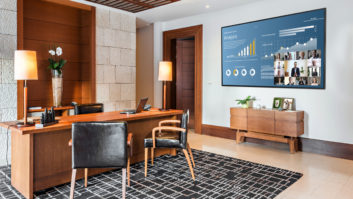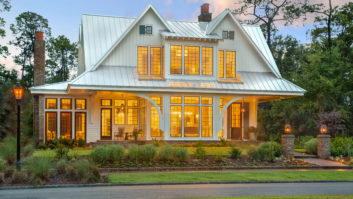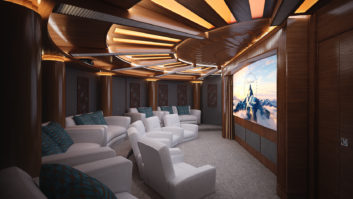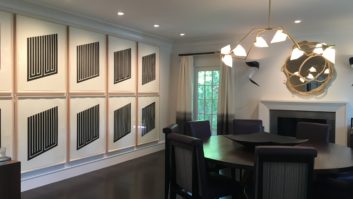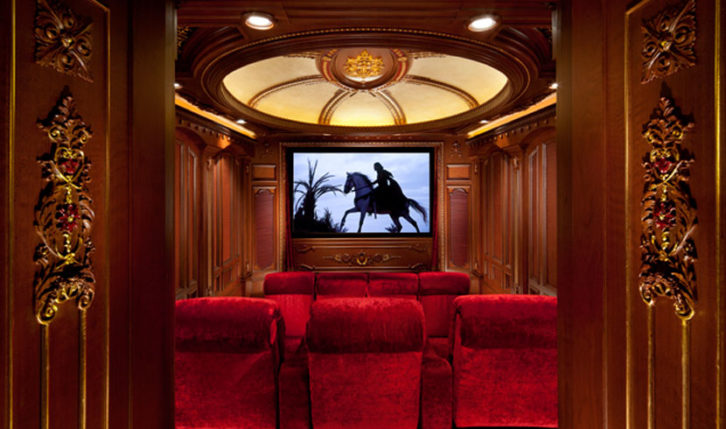
Big or small, elaborate or basic, a home theater is a collection of many moving parts. When you’re involved in a new construction project, there are even more pieces to fit into the puzzle. The room dimensions and ceiling height, the structural composition of the space, HVAC, lighting and other mechanical and electrical requirements, space allocations for equipment, and the list goes on. Sure, as the AV integrator you may not be directly involved in the physical construction of a home theater, but your input is crucial to the overall objective of the project. You might not be building risers and prosceniums, but building and maintaining a strong, solid relationship with the builder is imperative — especially on luxury projects.

Tech Advances Demand Closer Teamwork
Like any technology, AV components are in a constant state of improvement, refinement, and advancement. An integrator must keep abreast of the evolution and convey its importance to builders, as what’s trending now could be out of date when it’s time to button up a large home theater project. This impacts the construction process, so make sure to stay in close communications with the builder during the entire project. The quicker you relay information to him, the quicker he can respond with a structure that best accommodates your technology.
Your Builder Liaison
The builder/integrator relationship has been an ongoing topic of discussion for years. Words of wisdom have been shared by your peers as well as from tech-savvy builders, including how to approach builders, how to communicate effectively with them, how to maintain a smooth workflow, and how to modify your business practices accordingly. But have you ever thought to enlist the help of a home theater designer to facilitate outreach and engagement with the builder? They can be a valuable communications liaison, mediator, and production manager — all with the goal of creating a space that’s structurally sound, visually stunning, and exceptional in its AV performance.
Strike While the Plans Are Hot
Newly constructed home theaters are often given a certain allocated space within the home plans by an architect. The elements of this space, such as traffic flow and equipment placement, are typically not clearly defined yet, so it’s the perfect time for a home theater designer to collaborate with the builder, acoustician, and AV integrator. As the plans for the home theater are collectively formulated by the entire team, a set of detailed drawings and documents can be developed by the home theater designer as a framework for the builder to start putting costs together and alleviating some of the pressure and demands of doing this yourself. Moreover, getting a head start on this phase of the project saves confusion and missteps later, which typically cause time and cost overruns — risking profitability and client satisfaction.
This commitment to collaboration benefits the AV integrator/builder relationship immensely by providing a clear direction and a clearinghouse for the technology design and integration into the space. A home theater designer can provide a set of construction documents that serve as the road map for the builder to execute. This precludes many issues from cropping up later on in the process, resulting in a more streamlined workflow, reduction in change orders, and greater success for your company. Plus, when a home theater designer handles the detailed drawings and documents for the project, that’s less labor, time, and money an AV integrator needs to spend.
A recent project, which according to our design plans would feature an ornate, complex “grid” on the ceiling integrating 26 custom-made speakers for a Dolby Atmos installation, could have been a real nightmare for both the builder and the AV integrator. By approaching the project with both the design and technology in mind, our home theater design team was able to develop a recommended construction plan that the builder could then implement. Sharing our collective design and technology requirements with the builder allowed him to build unique allowances to achieve proper speaker spacing that met Dolby Atmos specifications.
Similar situations occur when a large screen has been specified for the space. The room might have the dimensions to support the size of the screen, but when other elements are factored into the equation, such plans for a proscenium, the overall design of the space often needs to shift and shift quickly to maintain the quality of the visual presentation. By understanding the screen as a priority early on allows a home theater designer enough time to devise a solution. Thanks to input and modification of the original design concept from a home theater designer, a builder can proceed with his finish carpentry.
One Happy Home Theater Family
In any working environment, having a neutral party take the lead can benefit everyone involved. A tech-savvy home theater designer can be this resource, facilitating a relationship between AV integrators and builders, while relieving you and your team of some of the burden, to ensure that all parties are on the same page and that the vision of the client is met in a timely, cost-effective manner.
With more than 20 years designing luxury home theaters for high-end properties around the globe, plus an extensive understanding and appreciation for AV technology, Lisa Slayman of Slayman Cinema is a valuable resource for home systems integrators. Slayman Cinema has won several awards, including the International Best Overall Home Theater from CEDIA. Slayman is also a member of the American Society of Interior Designers and the International Design Association.
Want more stories like this delivered to your inbox every day? Then sign up for the free Residential Systems eNewsletter here.
